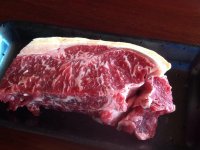librarian said:
I guess that was what confused me. I am looking at Galloway data and there are some with high marbling and low back fat. Others in the set were high in both. I thought marbling went in last, so it seems they must have saturated on that early. I need some wooly rhino data to compare it to, I guess.
Maybe this is the reason Galloway x Hereford works well on grass.
What Galloway data are you looking at? The ultrasound results the AGBA has taken at the NWSS are of cattle fed very differently. Some have had show feed for quite some time, and some are shown fairly green with little to no grain.
The Galloway breed tends to work well on grass, with marbling and minimal backfat by 18-24 months. This is what I hear from other breeders and customers, as we do not grass finish.
The Galloway crossed with every breed makes good cattle. <cowboy>
Picture is of a grass fed Galloway Sirloin steak.

